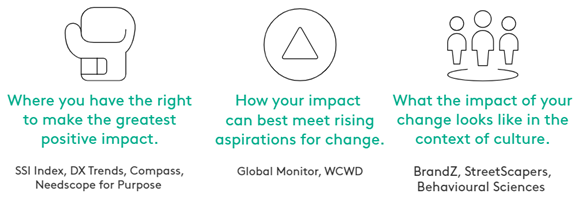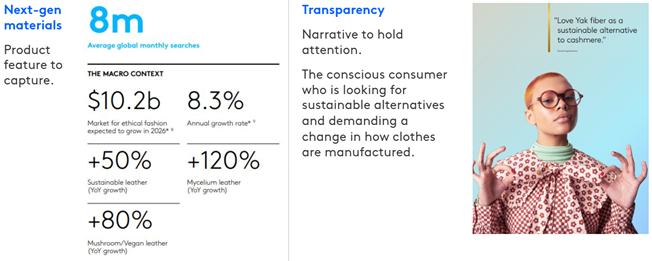Three key elements help land any sustainability ambition in the hearts and minds of consumers. Firstly, defining the nature of your leadership. Secondly, owning the right narrative. And finally, understanding how to resonate within different cultural settings.
But before we begin, the desire for change needs to be within us, as marketers. And it is, in spades. A 2023 combined Kantar/WFA report found that 90% of us want to be more ambitious in our sustainability agenda, and 94% of us said we need to act more bravely and experiment more boldly to drive transformational change. So, what is holding us back?
The operative word here is transformation. Sustainability isn't simply just another marketing initiative, or an isolated campaign idea. It requires us to think differently about the three core fundamentals of how we build and activate sustainability in our brands.
Driver 1: Leadership
Let’s start with leadership. We define this as identifying solutions that lead to a better future. And in an increasingly noisy brand universe, one opportunity stands out as having the potential to drive growth. This is by defining our brand’s social utility, the positive impact it can have in the world.
At Kantar we fundamentally believe the key to defining this social utility is to see it as an act of leadership, not an act of compliance. The reality is that for consumers, sustainability isn't an act of compromise. Greater sustainability or social utility cannot come at the cost of product performance, or increased price.
It also doesn’t have to come at the cost of decreased margins. A recent collaboration with the Said School of Business at Oxford University interrogated the financial models of the 17,000 brands in Kantar’s BrandZ database and 200,000 ads in our link testing data set, covering market capitalisation, risk, profitability and corporate investment. We found that the brands with a credible social utility outperform their competitors by an average of 20% in short term sales and 44% in terms of brand-building effect.

To help our clients know where they can play, we use a combination of our Sustainability Sector Index to identify the ‘swords & shields’ in the given category, then leverage our digital analytics & brand tools to tighten the potential impact any initiatives may have.
Using Kantar Monitor data, we can also forecast the aspirations people will have into the future. Finally, our behavioural science teams use Streetscape to build a picture of what the positive impact may look like and the changes needed in the real world to get there.
Mark Kennedy, Kantar Managing Partner, Australia: ‘Own something, make it ambitious, make it challenging, and don't congratulate yourself too much, (just) be useful to people and the world around you’.
Driver 2: The right narrative
Narrowness of sustainability messaging around product (e.g. recyclable) is no longer the currency. Rather than speaking ‘at people’, we need to hold their attention through an ongoing journey that outlines the difference we are seeking to make in the world. One that can travel across different cultures, across different social media platforms and that can be updated as the voyage develops.
In building this narrative, the subject matter, wording & tonality are key, so people will literally feel that we are speaking to their ambitions, using the same language as they do. Because we do, because we are genuine.
Internally too, championing a strong narrative can push the dial. The Yale’s Centre of Business and Environment found out that stronger, more ambitious narratives drove higher talent attraction, attraction, retention and higher levels of satisfaction among employees.
Looking at the fashion world, for example, some of today’s hot topics opportunity spaces include challenging perceptions of individuality and identity (modest fashion), new materials & sustainable sourcing, fairer fashion and ethical manufacturing. All driving a lot of interest and therefore offering the opportunity to really move the needle in terms of holding people’s attention and going beyond a product benefit.

‘We explore opportunity spaces for bigger, more ambitious, and aspirational narratives with the power of AI and digital data. Today we have the ability to understand the landscape, inspire incremental sustainable innovation and explore new spaces that transcend geographical borders and categories faster and at a lager scale than ever before’. Cynthia Vega, Kantar Global Head of Digital Analytics (Dx).
Switching to the food world, we see opportunities around living healthy lifestyles through food that can help the heart, the gut, the liver; functional food and it’s linkage to health and the supply chain. Consumer interest in the supply chain, traceability and transparency is changing hugely, questioning how we are thinking about regenerating - what happens to the soil after we produce and consume food for example. From hormone and antibiotic free food to sea-foraged ingredients, demand moving from ‘just the product’ to concerns where we can truly make change happen for people and for the planet. All worthy contenders for a new, game-changing narrative.
Driver 3: Resonating with culture
Having defined what we will make happen, and the narrative that speaks to this ambition, the final step is to communicate this in a way that will drive cut through and avoid accusations of green- and social- washing. The key to this is to be culturally resonant, to be clear, loud and evocative in how we talk about the impact our brand will have.
Crucially, the language of culture must trump the language of categories. Culture is more vibrant, more energised, more engaging, and more interesting than any product or service category can hope to be.
Differentiating ourselves means being part of the conversations that are relevant to people and how they talk and feel about sustainability.
At Kantar we identify the emerging semiotic and semantic of cultural conversations, to define the places, the people and the passions where these conversations are finding the greatest heat in culture.
Defining this is the difference between a brand starting a conversation about itself and playing a meaningful role in a pre-existing conversation that people are already having and are already engaged with. In essence, the difference between talking about yourself, and talking to, and with, people.
Brands that successfully leverage culture share 4 key behaviours. These are being more authentic, more rooted, more potent, and more simple. Our studies show that brands with these habits are up to three times more effective in making people feel confident, inspired, excited and proud to tackle the challenges of sustainability than their competitors are.
Think of IKEA’s honesty and simplicity in encouraging others to join them in the journey in a way that's deeply authentic to the brand's utilitarian roots.
A great example of being rooted comes from Heaps Normal, Australia's first purely non-alcoholic beer brand. They avoid the usual craft beer tropes of a love of brewing, but instead share a deep sense of place and belonging in the occasions in which they're consumed and shared.
Potency means being more useful and having higher performance, as no-one wants to compromise on performance to be more sustainable.
The snack brand Rind does this amazingly well. It launched in 2018 with the tagline ‘all taste, no waste’, baking in sustainability to its promise. The GM-free, organic, nutrient-dense, skin-on snacks promise a better alternative for increasingly health-conscious consumers. And through the prevention of wasted, imperfect fruit they offer one way to tackle the issue of food waste head on. This positive impact on people on planet has made Rind the second largest brand in the dry fruit category in the US, with an estimated CAGR of 7.9% through to the end of the decade.
Lastly, simplicity. Being more simple means being intuitive and easy to deal with, not overly worthy or daunting. Remember, sustainability is cool, it's positive, it's ambitious, and it can be fun and exciting. Take Tony’s Chocolonely. They talk about the serious subject matter of ending the slave trade in cocoa, but they never forget the simple joy of chocolate. Tony’s gives people an easy way to make a better choice in choosing chocolate that has a positive benefit for both them and for the planet.
The Hill’s pet food case study
So how do the three core elements of leadership, narrative and resonating through culture all come together?
One client keen to explore how to make sustainability a central growth driver of their business, was Hill’s Pet Food, USA. Alongside their leadership team, we sought to define their social utility in 10 potential impact spaces.
But which of these potential narrative spaces would play out best for them? Ultimately our research identified the opportunity narrative of ‘using the science of nutrition to heal the world, one bowl at a time’. This opened the door to not just being able to improve the health of pets, but also of people & planet. Enabling us also to build on the internal existing strategy, while taking us away from the siloed sustainability initiatives around product development and price, to a new narrative central to the whole business.
Dan Robertson-Jones, a Partner in Kantar Australia, sums up the cultural success story for Hill’s: ‘By unlocking the power of culture, their great work and their ambition has come to life all over the world for furry family members, hardworking pets, and hard-working vets’.
This article is based on the Building Sustainable Brands in Culture session of Kantar's Making Sustainability Real conference. You can access the on-demand session here.



